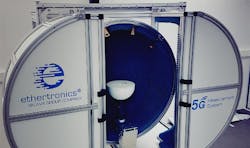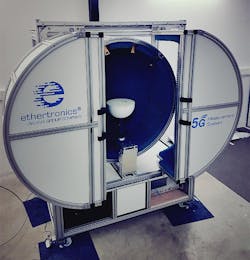New Test Chamber Opens Doors to 5G mmWave Devices
No doubt, next-generation 5G millimeter-wave (mmWave) devices will require sophisticated test solutions. With that in mind, Ethertronics recently announced its 5G mmWave test services and chamber to evaluate 5G antenna performance (see figure). The company showcased its new technology at the 2018 Mobile World Congress.
The mmWave 5G test chamber developed by Ethertronics can handle frequencies from 28 to 60 GHz.
“Our 5G chamber shows how we can not only design and manufacture, but also test mmWave antennas,” said Laurent Desclos, vice president and general manager, Ethertronics/AVX antenna division. “There is lots of discussion about how 5G is right around the corner. For mmWave antenna solutions, the challenges are not only designing them, but also manufacturing them to have the precision and the accuracy that is needed and then being able to verify and test. For us to be a one-stop shop and provide all these services to our customers, we went down the avenue of developing our own anechoic chamber so that we can design and test our antennas for the upcoming 5G market.”
In terms of frequencies, Ethertronics’ test chamber is intended for testing from 28 to 60 GHz. Desclos noted the feedback received from one of its partners, “We have one partner we’ve been working with; we’ve been developing and testing antennas for them. They are now interested in acquiring one of our chambers just because of its capabilities and performance.”
The mmWave 5G test chamber is able to characterize a wide range of parameters, including gain, directivity, beamwidth, 3D radiation pattern, and antenna efficiency. The test chamber has also been designed to support forthcoming 5G mmWave regulatory and emissions testing standards.
In addition, sub-1-degree accuracy in both elevation and azimuth angles can be achieved due to fine-stepped in-chamber device-under-test (DUT) rotation. On top of that, users can take advantage of the user-interface (UI) software tools for measurement and post-processing tasks.


